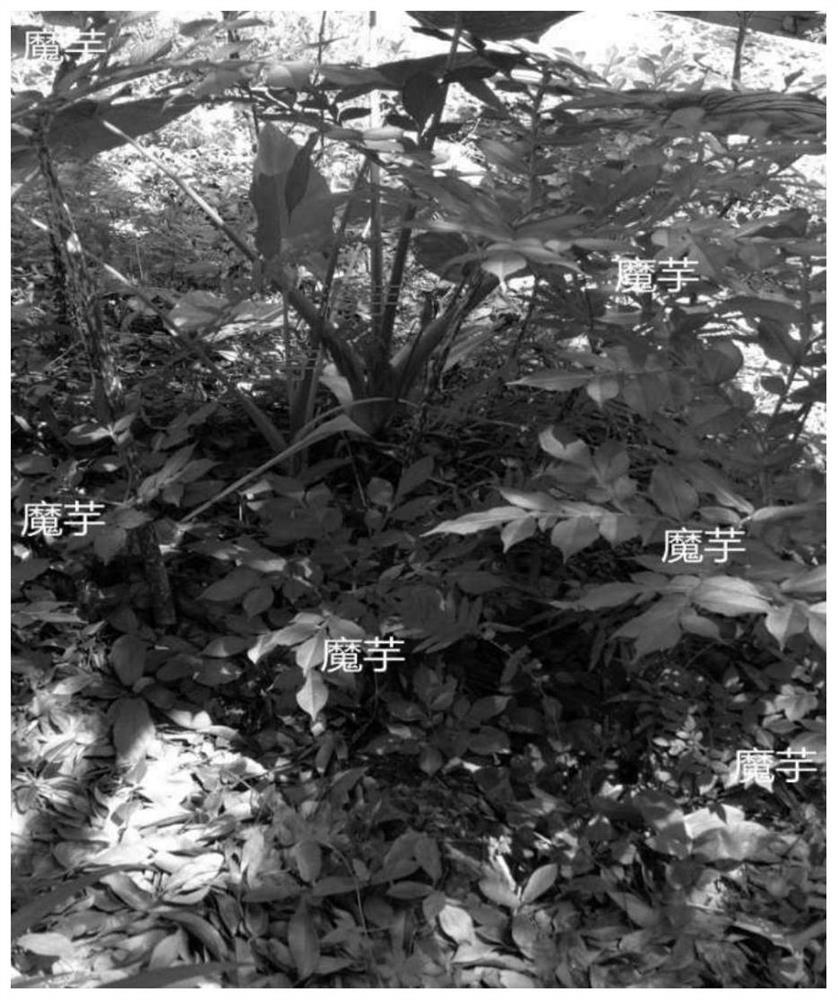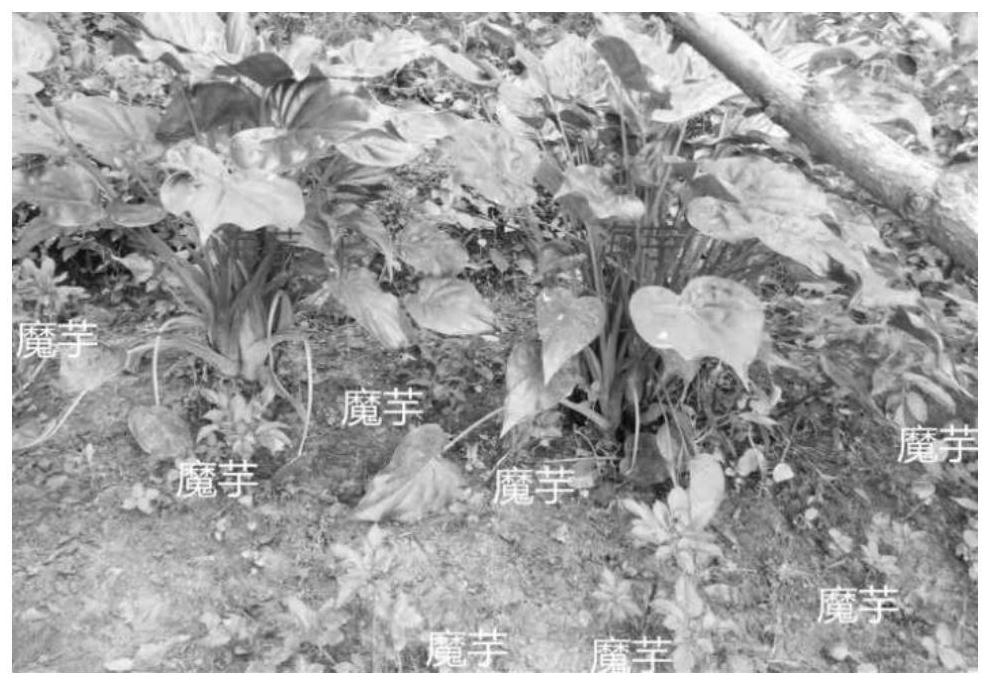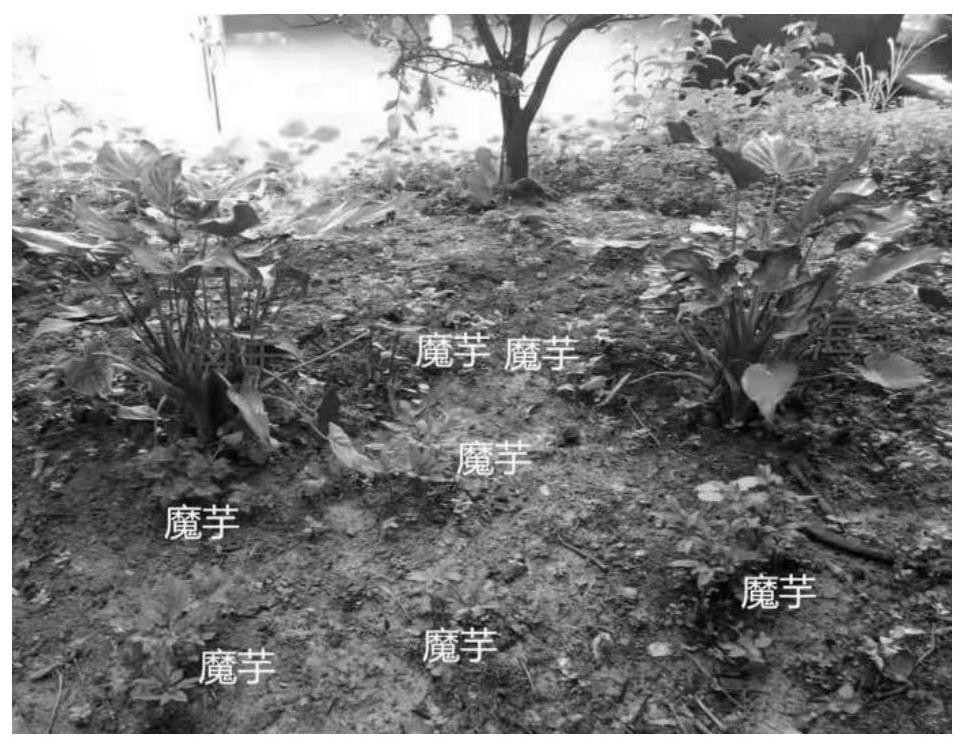Method for disease-resistant cultivation of amorphophallus rivieri durieu under low-altitude forests
A low-altitude, konjac technology, applied in root crop cultivation, botanical equipment and methods, horticulture, etc., can solve the problems of limited arable land resources, sharp decrease in konjac yield, aggravated disease spread, etc., and achieve stable increase in konjac yield, Strong survivability and obvious economic benefits
- Summary
- Abstract
- Description
- Claims
- Application Information
AI Technical Summary
Problems solved by technology
Method used
Image
Examples
Embodiment 1
[0029] A method for disease-resistant cultivation of konjac under a low-altitude forest, the method comprising the following steps:
[0030] 1) Select the idle land under the camphor forest (Figure 1), at an altitude of 200-250 m;
[0031] 2) Plowing and leveling the under-forest land;
[0032] 3) Apply crushed dry rice straw and decomposed pig manure to the plowed soil, and the amount of dry rice straw is 0.15 kg / m 2 , decomposed pig manure (water content about 50%) 0.4 kg / m 2 ;
[0033] 4) Planting calla lilies ( Alocasia macrorrhizae (L.) Schott), 2-4 m 2 plant a plant;
[0034] 5) Plant konjac around the calla lily, the size of konjac species is 60-150 g / piece, plant 4-7 per square meter;
[0035] 6) Detect and record the growth status of konjac. The growth of konjac is normal, and there is no lodging phenomenon during the three-year growth period;
[0036] 7) Konjac tubers are harvested in the third year, and the weight of the harvested konjac tubers is 3.7 times ...
Embodiment 2
[0038] A method for disease-resistant cultivation of konjac under a low-altitude forest, the method comprising the following steps:
[0039] 1) Choose mountain miscellaneous forests, under which there are weeds and small shrubs (Figure 2), at an altitude of 300-450 m;
[0040] 2) Plowing and leveling the under-forest land;
[0041] 3) Apply fallen leaves to the plowed soil at an amount of 0.35 kg / m 2 ;
[0042] 4) Planting calla lilies ( Alocasia macrorrhizae (L.) Schott), 2-4 m 2 plant a plant;
[0043] 5) Plant konjac around the calla lily, the size of konjac species is 60-150 g / piece, plant 4-7 per square meter;
[0044] 6) Detect and record the growth status of konjac. The growth of konjac is normal, and there is no lodging phenomenon during the one-year growth period;
[0045] 7) Konjac tubers were harvested in the same year, and the number of konjac tubers harvested was 4.3 times the number of konjac seeds used for sowing. The planted konjac seeds were divided int...
Embodiment 3
[0047] A method for disease-resistant cultivation of konjac under a low-altitude forest, the method comprising the following steps:
[0048] 1) Choose a citrus forest (Figure 3), at an altitude of about 230 m;
[0049] 2) plowing and leveling the land;
[0050] 3) Apply decomposed pig manure (water content about 50%) to the plowed soil 0.5 kg / m 2 ;
[0051] 4) Planting calla lilies ( Alocasia macrorrhizae (L.) Schott), 2-4 m 2 plant a plant;
[0052] 5) Plant konjac around the calla lily, the size of konjac species is 60-150 g / piece, plant 4-7 per square meter;
[0053] 6) Detect and record the growth status of konjac. The growth of konjac is normal, and there is no lodging phenomenon during the one-year growth period;
[0054] 7) Konjac tubers were harvested in the same year, and the number of konjac tubers harvested was 3.8 times the number of konjac seeds used for sowing. The planted konjac seeds were divided into 2-8 small konjac tubers, which were used as seed taro...
PUM
 Login to View More
Login to View More Abstract
Description
Claims
Application Information
 Login to View More
Login to View More - R&D Engineer
- R&D Manager
- IP Professional
- Industry Leading Data Capabilities
- Powerful AI technology
- Patent DNA Extraction
Browse by: Latest US Patents, China's latest patents, Technical Efficacy Thesaurus, Application Domain, Technology Topic, Popular Technical Reports.
© 2024 PatSnap. All rights reserved.Legal|Privacy policy|Modern Slavery Act Transparency Statement|Sitemap|About US| Contact US: help@patsnap.com










